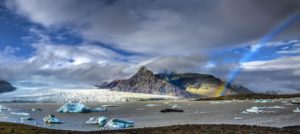
Iceland. Here, continental crust and oceanic crust become one. Photographed by Mike ADLER.
A VICTORY FOR THE PROLETARIAT
There are – in the same loose sense of the term that there are only two kinds of anything – only two kinds of Earth crust. Continental crust is the stuff of… well, continents. Oceanic crust is the stuff at the bottom of oceans. The Earth’s crust constitutes far less than one percent of the planet’s mass. It is often likened to the skin of an apple in terms of relative thickness. Oceanic crust is even thinner. Understanding the difference between these two types of crust is fundamental to understanding plate tectonics. And plate tectonics, as GJH V.P. John Hebberger often points out during our gatherings, deserves credit for keeping us above sea level.
Dry land is first and foremost a product of plate tectonics. It is widely held that much earlier in the Earth’s history there were no continents. The surface of Earth was one big ocean. This seems strange when one considers the fact that the oldest rocks on Earth today are all from continental crust. The reason for this is that continental crust is slightly less dense than oceanic crust. When the two collide, as they eventually do at convergent plate margins, the oceanic crust is always the loser. It, and the upper portion of the mantle upon which it “floats,” are subducted under the continental crust like a pleasure yacht being steamrolled under the business end of an oil tanker. This chaos produces many good things in the economy of continental evolution — mountain belts and volcanism being two good examples.
It goes without saying that if lithospheric plates are crashing into each other in one location, they must be pulling apart from each other in another. Plate tectonics accommodates this Newtonian mandate with spreading ridges. Resembling the stitching on a baseball, these divergent plate margins can be traced all around the planet and are sometimes referred to as “mid-oceanic ridges” because they tend to be in the middle of oceans. And if a new divergent plate margin pops up on dry land, it will in the fullness of time create its own ocean. Think Red Sea Rift or Gulf of California Rift Zone and you have the picture. New oceanic crust is perpetually rolled out of spreading ridges in both perpendicular vectors until it is eventually but inevitably subducted under continental crust. Continental crust, on the other hand, rides above it all and grows ever fatter and older, erupting the continent-building nutrients out of the melted remains of the vanquished oceanic crust.
So in one sense it is the oceanic crust that is doing all of the work, and the continental crust that is getting all of the glory. Certainly a fitting metaphor for the way much of the rest of the world functions. But all of this fails to answer a bigger question: Where did the continental crust come from in the first place? If the whole planet was one big ocean, how did the first continent come into being?
Iceland might provide some clues. Here, in this hauntingly beautiful and unique landscape, some scientists see a proto-continent that may resemble the first continents to rise above the proletariat fate of oceanic crust. There are, in some of the oldest continental rocks ever found, geochemical signatures that are remarkably similar to the rocks of Iceland, which straddle the Mid-Atlantic Spreading Ridge and are mostly less than 20 million years old. Here, in Iceland, the distinction between continental crust and oceanic crust becomes clouded. The geology of this special place is so interesting that plans are underway for a GJH field trip there. This Tuesday, (October 4th) at the Teton County Library Auditorium at 6:00 pm GJH member Mike Adler will introduce us to this amazing place as only he can. For our newest members and friends, be advised that Mike’s strong foundation in earth science is equally matched by his photographic genius. If you love geology and beauty, you will want to be there this Tuesday.

